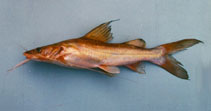| Family: |
Bagridae (Bagrid catfishes) |
| Max. size: |
65 cm SL (male/unsexed) |
| Environment: |
benthopelagic; freshwater; brackish; pH range: 7 - 8.19999980926514; dH range: 10 - 25; depth range - 5 m, potamodromous |
| Distribution: |
Asia: Mekong, Chao Phraya and Xe Bangfai basins; also from the Malay Peninsula, Sumatra, Java, Borneo. |
| Diagnosis: |
Dorsal spines (total): 2-2; Dorsal soft rays (total): 7-7; Anal spines: 0-0; Anal soft rays: 10-13. Body color brown often with greenish sheen. Fins gray with violet tint. Pectoral fin spines serrated along the inner edge. Base of adipose fin shorter than that of dorsal fin and about equal to that of anal fin. Barbels four pairs; nasal barbels extending to or beyond eyes, maxillary ones in anal fin, mandibulary ones beyond base of pectoral fins, mental ones 2/3 - 3/4 the distance between their base and insertion of pectoral fins (Ref. 4792). Head flattened rather than conical; rugose skull roof; depressed dorsal fin not reaching adipose fin; pectoral fin smooth in front; 9 branched anal rays (Ref. 12693). |
| Biology: |
Occurs in most habitat types, but most frequent in large muddy rivers, with slow current and soft bottom (Ref. 27732). Enters flooded forest (Ref. 9497). Feeds on exogenous insects, aquatic insect larvae, shrimps, other crustaceans and fishes. Moves into flooded forests to spawn and the young are usually first seen in August. In Tonlé Sap (Cambodia), maximum numbers are found as it returns to rivers in November and December. A highly priced aquarium fish. Usually marketed fresh (Ref. 12693). High in nutritive values especially omega-3 fatty acids (EPA, DHA) (Ref. 53337). |
| IUCN Red List Status: |
Least Concern (LC); Date assessed: 01 September 2018 Ref. (130435)
|
| Threat to humans: |
harmless |
Source and more info: www.fishbase.org. For personal, classroom, and other internal use only. Not for publication.
